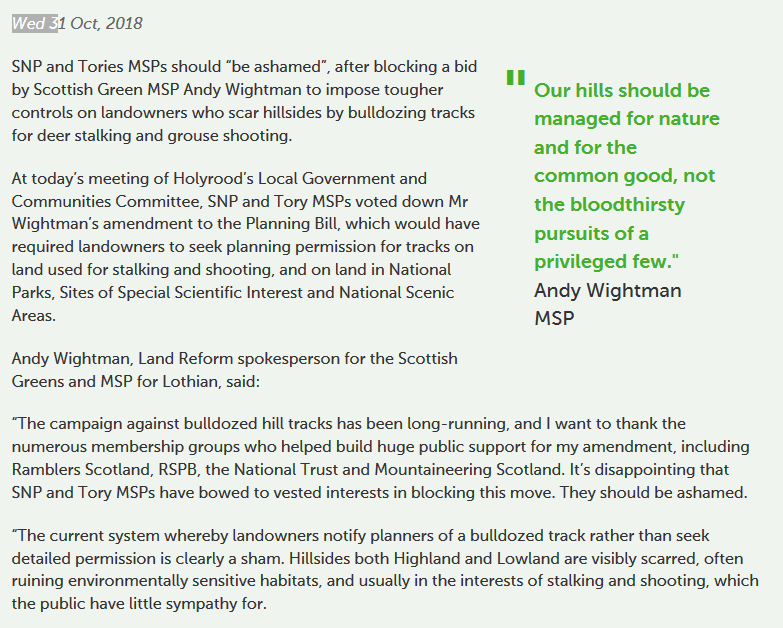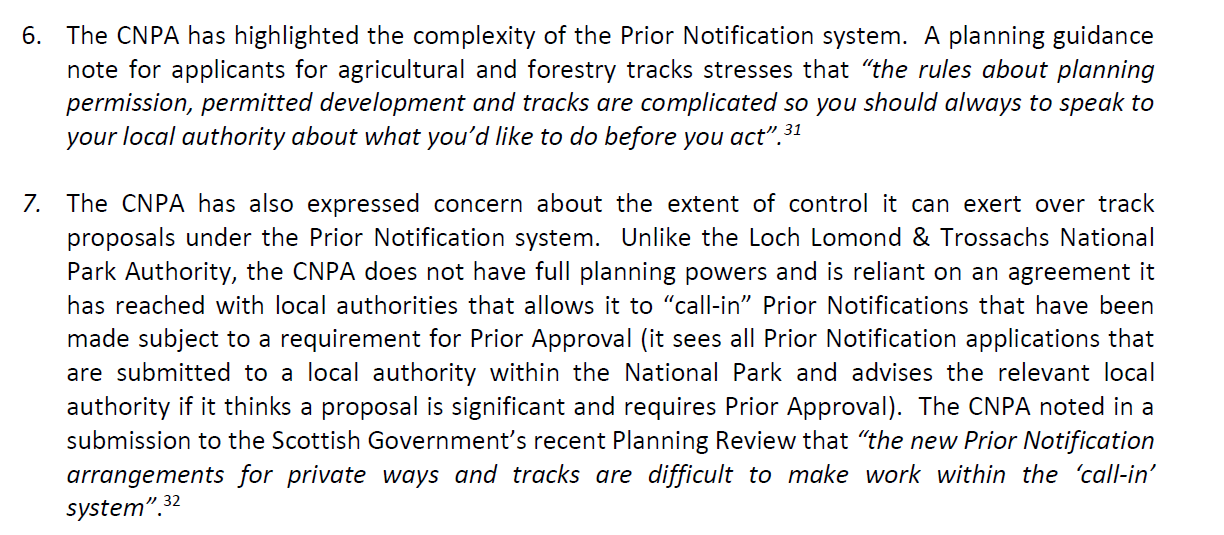
The proliferation of vehicle hill tracks in our National Parks, whether agreed through our planning system or not, has been a constant theme of Parkswatch over the last two and a half years. The first thing that we need to do to address the problem is to bring all vehicle tracks into the planning system and the second is then to improve our planning system so that tracks are only approved in appropriate areas and then designed and delivered to the highest standards. Unfortunately an attempt to address the first part of the issue through an amendment to the Planning Bill being considered by the Scottish Parliament was defeated yesterday:

Andy Wightman’s proposal followed Scottish Environment LINK’s publication of a report, “Changing Tracks the case for better control of vehicle tracks in Scotland’s widest landscapes” a few weeks ago (you can download the report the LINK hill tracks campaign page here). It got lots of good coverage as in this (short video) from Kevin Keane, the BBC’s Environment and Rural Affairs correspondent. The report is well researched and provides compelling evidence of the need for change but proposed a slightly different solution to Andy Wightman in suggesting that only agricultural tracks should be brought under full planning control for the time being.
Its worth understanding the politics behind the two proposals. Both assumed, probably rightly, that there was no chance at present of bring both agricultural and forestry tracks into the planning system in Scotland. The LINK proposal, therefore, would have left forestry tracks, whose landscape impact tends to be limited by the trees around them, under the Prior Notification system. This appears to have been partly an attempt to head off opposition from the Forestry Commission which is vehemently opposed to any extension of planning controls over forest tracks. Its disadvantage was that it could affect small farmers and crofters, who sometimes need to make what are quite minor changes to their tracks, which arguably is one thing that might be best dealt with through a Prior Notification system.
Andy Wightman’s amendment attempted to circumvent these issues by proposing that all tracks used for sporting purposes, whether or not also used for forestry and agriculture, should require full planning permission. This would have left small farmers and crofters alone but would have brought all tracks used for deer stalking and grouse shooting, the tracks which have had the biggest impact on our landscape, into the planning system. It would have also brought some forest tracks, where they are also used for “sporting” purposes – including pheasant shoots – under full planning control.
While following the defeat of his amendment, I hope that Andy Wightman and the organisations leading the arguments for change ill not give up as long as there is a chance to amend the Bill, I do think we need to consider other options. Our two National Parks should be central to this and indeed should have been in the lead up to the Planning Bill. With their statutory duties to protect the landscape, they more than any other public authority other than SNH, could be making the case for change. Moreover, unlike SNH, they are in a position to demonstrate both the potential and limitations of the current planning system.
“Changing Tracks” and our National Parks
The LINK report recognised this and contained two brief sections on the record of our National Parks in respect to hill tracks. Here is what they said about the Cairngorms National Park Authority:

And here, what the Report says about the Loch Lomond and Trossachs National Park Authority:
 In other words, while tracks in open country may not be such an issue in the LLTNPA, forestry tracks may be.
In other words, while tracks in open country may not be such an issue in the LLTNPA, forestry tracks may be.

The Report implies that the CNPA has expressed more concern than the LLTNPA about the landscape impact of tracks that currently fall OUTWITH the planning system and been prepared to say so to the Scottish Government. I believe that assessment is right. The LLTNPA’s recent silence of hill tracks is consistent with its disregard of the landscape impacts of they hydro tracks that do require full planning consent under our current system.
What our National Parks could be doing
The CNPA has expressed concerns publicly about the proliferation of tracks and indeed has consulted on including a presumption against ANY new ones in its new Local Development Plan. One might have hoped therefore it could have provided the Scottish Government with much stronger evidence for the failures of the Prior Notification and wider Planning System in respect to hill tracks based on its experience.
I today checked the CNPA’s Planning Enforcement Register and, apart from the grant of retrospective permission to the Glen Banchor track, none of other the tracks covered on Parkswatch features. So, for example, what is happening to:
- The unlawful Glen Clova hotel track (see here)?
- The unlawful track at the head of Glen Prosen (see here)?
- The unlawful Cluny Estate track at the head of Glen Banchor which had appeared on the Planning Enforcement Register but where there has been no update since the original action was discontinued (see here)?
- The section of Beauly Denny track north of North Drumochter lodge (to be featured soon)?
- Phase 2 of the restoration of the unlawfully constructed tracks on the Dinnet Estate (see here)?
- Other Pitmain Estate tracks (see here)
What’s happening or not is not public despite some of these issues going back well over two years. This could have provided an ideal opportunity for the CNPA to submit detailed evidence to the Scottish Parliament about the current challenges facing planning authorities who DO want to address the proliferation of hill tracks and which of these can be attributed to the Prior Notification system. It also provided the perfect the opportunity to make a further detailed case for further powers and resources if these are not sufficient at present.
Whatever happens with the Planning Bill, it would be in the public interest if the CNPA compiled a full report and analysis of the challenges they currently face with hill tracks. This would both help inform the debate nationally but also help inform its new Local Development Plan. A planning policy presumption against new tracks on open moorland is all very well but unless the CNPA has the detailed policies, procedures and resources in place to take swift enforcement action these aspirations will remain wishful thinking.
The CNPA also needs to widen the scope of the debate by looking at how uncontrolled ATV use eventually leads to tracks. That in effect explains the Glen Banchor track behind Newtonmore which they granted planning permission to in the summer (see here) and is still responsible for track creep across the National Park (see top photo). While ATV use falls outwith the scope of the planning system, it could be addressed through our National Park’s powers to make byelaws for conservation purposes. Why not require ALL use of vehicles off road in National Parks to require a license/permissions just as in Sites of Special Scientific Interest where SNH can control vehicle use as an “Operation Requiring Consent”?
The LLTNPA should, however, not be let off the hook here. In the western part of the National Park they have some of the largest concentrations of industrial conifer forestry, and alongside that, industrial forest tracks in Scotland. These are, to put it mildlly, poor for landscape, wildlife and outdoor recreation yet the main action of the LLTNPA to date is give the nod to any Prior Notification that comes its way from Forestry Commission Scotland . Its time that the LLTNPA reviewed and reported on what is really happening and considered how to address the issues.
Whatever the final outcome of the Planning Bill, ugly and poorly constructed tracks are not an issue that is going to go away.

One of the reasons Andy Wightman`s bill was vetoed was that the SNP has a paranoid liking for wind turbines. They new that if Andy`s bill was passed it would take ages for the planning process to agree to new tracks etc. That’s my view for what it is worth.